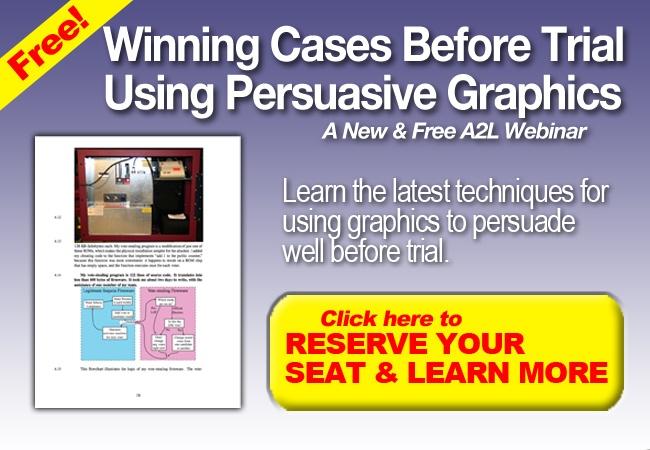by Ken Lopez
Founder/CEO
A2L Consulting
Over breakfast the other day, a partner in a major law firm was explaining to me that it can be challenging to explain the added value that litigation graphics consultants can provide in a case, especially given the challenging budget environment in which litigators operate today. He was surprised when I said that the key here is not the fact that graphics consultants know how to prepare PowerPoints.
After all, the average law firm associate can prepare a pretty decent PowerPoint presentation. The problem is that perhaps one in 500 PowerPoints prepared by a smart and well-informed law firm associate does more good than harm. What litigation consultants can do for a trial team is more complex, more persuasive and more sophisticated.
So here are ten ways in which a litigation graphics consultant would add value where a litigation associate might cause harm or simply might not provide benefit.
1. Supporting the development of a narrative. We've written about this extensively, and great graphics consultants like those at our firm have enormous value here. One of the essences of trial presentation is telling a narrative. See, $300 Million of Litigation Consulting and Storytelling Validation.
2. Helping separate the theme from the narrative. Many of us who took trial advocacy were taught to start out our openings with "this is a case about . . . ." After that, we would usually state our theme. What many lawyers were not taught was how to develop a persuasive narrative. A few rare litigation graphics consultants can operate at the 1st chair level and offer this kind of support. See, 14 Differences Between a Theme and a Story in Litigation and 21 Reasons a Litigator Is Your Best Litigation Graphics Consultant.
3. Helping combat the now-fashionable “Reptile” trial strategy tactics that plaintiffs lawyers use. We have discussed this in several recent blog posts. See, Repelling the Reptile Trial Strategy as Defense Counsel.
4. Making sure that you don’t invoke the split attention or redundancy effect. This is the error of presenting information orally and in writing at the same time. See, Why Reading Your Litigation PowerPoint Slides Hurts Jurors.
5. Offering that fresh pair of eyes. See, 12 Reasons Litigation Graphics are More Complicated Than You Think.
6. Creating a high-end PowerPoint that makes a positive difference. See, 16 PowerPoint Litigation Graphics You Won't Believe Are PowerPoint.
7. Freeing up litigation counsel to be lawyers. My mentor likes to say that we should only do what we are best at. In the run-up to a trial or hearing, there is always more legal work that needs to be done. The role of litigators should be to review draft presentations and provide feedback to the consultants who have actually developed the presentation. See, Trial Graphics Dilemma: Why Can't I Make My Own Slides? (Says Lawyer).
8. Litigation consultants can use nearly unknown techniques for persuasion like surprise, chart tricks, statistical persuasion or methods to overcome cognitive bias.
9. Asking tough questions. See, How I Used Litigation Graphics as a Litigator and How You Could Too.
10. Bringing to the fore their extensive trial experience. Top trial consultants such as those on our team may go to trial 50 to 100 times per year. By working with them, trial lawyers gain the benefit of hearing about the best practices of other trial teams. See, With So Few Trials, Where Do You Find Trial Experience Now?
Other articles and resources on A2L Consulting's site related to litigation graphics, storytelling for persuasion, trial graphics and demonstrative evidence:
- 21 Reasons a Litigator Is Your Best Litigation Graphics Consultant
- 16 PowerPoint Litigation Graphics You Won't Believe Are PowerPoint
- 10 Things Litigation Consultants Do That WOW Litigators
- 6 Studies That Support Litigation Graphics in Courtroom Presentations
- FREE Webinar: Persuading with PowerPoint Litigation Graphics
- FREE Webinar: Storytelling as a Persuasion Tool
- 10 Things Litigators Can Learn From Newscasters
- FREE Webinar: Patent Litigation Graphics
- With So Few Trials, Where Do You Find Trial Experience Now?
- FREE Download: Using Litigation Graphics
- 7 Questions Will Save You Money with Litigation Graphics Consultants
- 16 Litigation Graphics Lessons for Mid-Sized Law Firms
- 13 Reasons Law Firm Litigation Graphics Departments Have Bad Luck
- FREE Download: Why Using a Litigation Consultant is Beneficial to You
- FREE Download: Storytelling for Litigators
- The 12 Worst PowerPoint Mistakes Litigators Make
- 6 Trial Presentation Errors Lawyers Can Easily Avoid
- The 14 Most Preventable Trial Preparation Mistakes
- Trial Graphics Dilemma: Why Can't I Make My Own Slides? (Says Lawyer)
- Why Reading Your Litigation PowerPoint Slides Hurts Jurors






Leave a Comment